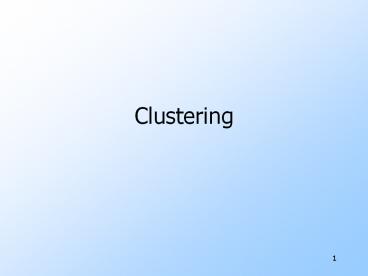Clustering - PowerPoint PPT Presentation
Title:
Clustering
Description:
BFR (Bradley-Fayyad-Reina) is a k-means variant that compresses points near the center of clusters. Also compresses groups of outliers. – PowerPoint PPT presentation
Number of Views:95
Avg rating:3.0/5.0
Title: Clustering
1
Clustering
2
The Problem of Clustering
- Given a set of points, with a notion of distance
between points, group the points into some number
of clusters, so that members of a cluster are in
some sense as nearby as possible.
3
Example
x xx x x x x x x x x x x x
x
x x x x x x x x x x x x
x x x
x x x x x x x x x x
x
4
Applications
- E-Business-related applications of clustering
tend to involve very high-dimensional spaces. - The problem looks deceptively easy in a
2-dimensional, Euclidean space.
5
Example Clustering CDs
- Intuitively, music divides into categories, and
customers prefer one or a few categories. - But whos to say what the categories really are?
- Represent a CD by the customers who bought it.
- Similar CDs have similar sets of customers, and
vice-versa.
6
The Space of CDs
- Think of a space with one dimension for each
customer. - Values 0 or 1 only in each dimension.
- A CDs point in this space is (x1,x2,,xk), where
xi 1 iff the i th customer bought the CD. - Compare with the correlated items matrix rows
customers cols. CDs.
7
Distance Measures
- Two kinds of spaces
- Euclidean points have a location in space, and
dist(x,y) sqrt(sum of square of difference in
each dimension). - Some alternatives, e.g. Manhattan distance sum
of magnitudes of differences. - Non-Euclidean there is a distance measure giving
dist(x,y), but no point location. - Obeys triangle inequality d(x,y) lt
d(x,z)d(z,y). - Also, d(x,x) 0 d(x,y) gt 0 d(x,y) d(y,x).
8
Examples of Euclidean Distances
y (9,8)
L2-norm dist(x,y) sqrt(4232) 5
3
5
L1-norm dist(x,y) 43 7
4
x (5,5)
9
Non-Euclidean Distances
- Jaccard measure for binary vectors ratio of
intersection (of components with 1) to union. - Cosine measure angle between vectors from the
origin to the points in question.
10
Jaccard Measure
- Example p1 00111 p2 10011.
- Size of intersection 2 union 4, J.M. 1/2.
- Need to make a distance function satisfying
triangle inequality and other laws. - dist(p1,p2) 1 - J.M. works.
- dist(x,x) 0, etc.
11
Cosine Measure
- Think of a point as a vector from the origin
(0,0,,0) to its location. - Two points vectors make an angle, whose cosine
is the normalized dot-product of the vectors. - Example p1 00111 p2 10011.
- p1.p2 2 p1 p2 sqrt(3).
- cos(2) 2/3.
12
Example
011
110
110
010
101
001
100
13
Cosine-Measure Diagram
p1
2
p2
p1.p2
p2
dist(p1, p2) 2
14
Methods of Clustering
- Hierarchical
- Initially, each point in cluster by itself.
- Repeatedly combine the two closest clusters
into one. - Centroid-based
- Estimate number of clusters and their centroids.
- Place points into closest cluster.
15
Hierarchical Clustering
- Key problem as you build clusters, how do you
represent the location of each cluster, to tell
which pair of clusters is closest? - Euclidean case each cluster has a centroid
average of its points. - Measure intercluster distances by distances of
centroids.
16
Example
(5,3) o (1,2) o o (2,1) o
(4,1) o (0,0) o (5,0)
x (1.5,1.5)
x (4.7,1.3)
x (1,1)
x (4.5,0.5)
17
And in the Non-Euclidean Case?
- The only locations we can talk about are the
points themselves. - Approach 1 Pick a point from a cluster to be the
clustroid point with minimum maximum distance
to other points. - Treat clustroid as if it were centroid, when
computing intercluster distances.
18
Example
clustroid
1
2
4
6
3
clustroid
5
intercluster distance
19
Other Approaches
- Approach 2 let the intercluster distance be the
minimum of the distances between any two pairs of
points, one from each cluster. - Approach 3 Pick a notion of cohesion of
clusters, e.g., maximum distance from the
clustroid. - Merge clusters whose combination is most cohesive.
20
k-Means
- Assumes Euclidean space.
- Starts by picking k, the number of clusters.
- Initialize clusters by picking one point per
cluster. - For instance, pick one point at random, then k -1
other points, each as far away as possible from
the previous points.
21
Populating Clusters
- For each point, place it in the cluster whose
centroid it is nearest. - After all points are assigned, fix the centroids
of the k clusters. - Reassign all points to their closest centroid.
- Sometimes moves points between clusters.
22
Example
2
4
x
6
1
3
5
7
8
x
23
How Do We Deal With Big Data?
- Random-sample approaches.
- E.g., CURE takes a sample, gets a rough outline
of the clusters in main memory, then assigns
points to the closest cluster. - BFR (Bradley-Fayyad-Reina) is a k-means variant
that compresses points near the center of
clusters. - Also compresses groups of outliers.































